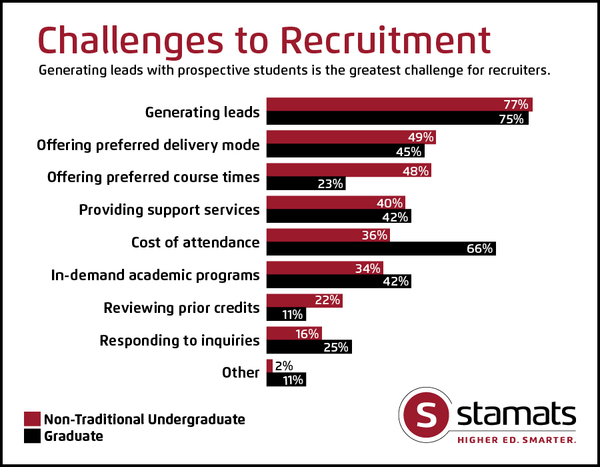
Becky Morehouse
April 4, 2019

Rarely does one graphic so clearly illustrate the relationship between policy decisions and recruiting success.
These data, drawn from the Stamats annual Adult StudentsTALK™ study, were gathered from adult and graduate student marketing and recruiting professionals in response to: What challenges do you face in recruiting adult and/graduate students?
As you can see, answers have implications for 32,000-foot policy issues as well as in-the-trenches recruiting issues.
Let’s tackle the high-altitude policy issues first:
The difficult reality is that decisions around these issues directly impact the overall success rate of in-the-trenches recruiting efforts. When “product” decisions like these are made with adult undergraduate and graduate students in mind, the recruiting process is much easier. At the same time, poor high-altitude decisions often result in a series of insurmountable issues for even the best marketers and recruiters.
The solution is logical: Include marketing and admissions professionals in decisions related to product, price, and place issues. Their voices at the big table will help policy makers understand not only the importance of student-centric decisions, but also the high cost of poor—or no—decisions.
One particularly problematic and entrenched policy issue relates to cost. Everyone recognizes that college costs money. We also know that many individuals and families simply have not (or could not have) saved for college. Colleges must charge something, and for individuals with few or no resources, almost any cost is too high.
There are two ways to address the cost issue.
These solutions require institutional resources (i.e., staff time), but it also requires institutional will—the desire and ongoing fortitude to collect the stories and the data. Again, this is a high-altitude decision.
Using data lands more squarely on the shoulders of the marketing and recruiting teams. They must effectively package content marketing stories, testimonials, and hard data to enhance communication and advance the overall value proposition. We can’t discount the “voice” of value either. The credibility of a current or former student making the case for value is so much stronger and more effective than an administrator.
A nearly ubiquitous challenge voiced by marketing and admissions professionals is generating leads. This challenge, too, is directly related to decisions that are made at the policy level.
When organizations make poor program and delivery-mode decisions, generating leads for inadequate and unmarketable offerings will be that much more difficult. Students and alumni share horror stories rather than success stories. Competitors who cater offerings to nontraditional student needs dominate the market.
At the same time, if adult-student and market-centric decisions are made about programs and delivery modes, then the buzz will be both positive and persistent. Potential students will seek you out, making lead generation less onerous.
We call this creation of demand not lead generation, but demand generation.
Lead generation might not be a novel issue, but it is a persistent one. I believe many recruiting challenges result from poor product decisions. In-demand programs offered at the right time and place will, more often than not, mitigate many of the marketing and recruiting difficulties. Making this happen, however, will require that policy makers, marketers, and recruiters work together.
Are you ready to launch a demand gen program? Contact me for a consultation today.
Ready to Get Started?
Reach out to us to talk about your strategy and goals.